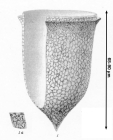WoRMS name details
Ascampbelliella obscura (Brandt, 1906)
417128 (urn:lsid:marinespecies.org:taxname:417128)
uncertain > taxon inquirendum
Species
marine, brackish, fresh, terrestrial
Brandt, K. (1907). Die Tintinnodeen der Plankton-Expedition. <em>Ergebnisse der Plankton-Expedition der Humboldt-Stiftung Systematischer Teil. 3.</em> 3: 1-499. [details] 
Xu, K.; Agatha, S.; Dolan, J. (2024). World Ciliophora Database. Ascampbelliella obscura (Brandt, 1906). Accessed through: World Register of Marine Species at: https://www.marinespecies.org/aphia.php?p=taxdetails&id=417128 on 2024-11-09
Date
action
by
2009-10-06 12:38:14Z
created
db_admin
![]() The webpage text is licensed under a Creative Commons Attribution 4.0 License
The webpage text is licensed under a Creative Commons Attribution 4.0 License
original description
Brandt, K. (1907). Die Tintinnodeen der Plankton-Expedition. <em>Ergebnisse der Plankton-Expedition der Humboldt-Stiftung Systematischer Teil. 3.</em> 3: 1-499. [details] 
basis of record Coats, D.W.; Clamp, J.C. (2009). Ciliated Protists (Ciliophora) of the Gulf of Mexico. Pp. 57-79 in D.L. Felder and D.K. Camp (eds.). <em>Gulf of Mexico. Origin, Waters, and Biota. Volume 1, Biodiversity.</em> Texas A&M University Press, College Station, Texas., available online at http://goo.gl/6nLK0Y [details] Available for editors [request]
[request]
additional source Komarovsky, B. 1959. The Tintinnea of the Gulf of Eytath (Aqaba). Bull. Sea Fish. Res. Sta., Haifa, 21:3-40. [details] Available for editors [request]
[request]
basis of record Coats, D.W.; Clamp, J.C. (2009). Ciliated Protists (Ciliophora) of the Gulf of Mexico. Pp. 57-79 in D.L. Felder and D.K. Camp (eds.). <em>Gulf of Mexico. Origin, Waters, and Biota. Volume 1, Biodiversity.</em> Texas A&M University Press, College Station, Texas., available online at http://goo.gl/6nLK0Y [details] Available for editors
additional source Komarovsky, B. 1959. The Tintinnea of the Gulf of Eytath (Aqaba). Bull. Sea Fish. Res. Sta., Haifa, 21:3-40. [details] Available for editors
 Present
Present  Present in aphia/obis/gbif/idigbio
Present in aphia/obis/gbif/idigbio  Inaccurate
Inaccurate  Introduced: alien
Introduced: alien  Containing type locality
Containing type locality
From editor or global species database
Validity This texture of the lorica and the size of the species resembles an Epiplocylis or Epiplocycloides not like the others in the genus. [details]
